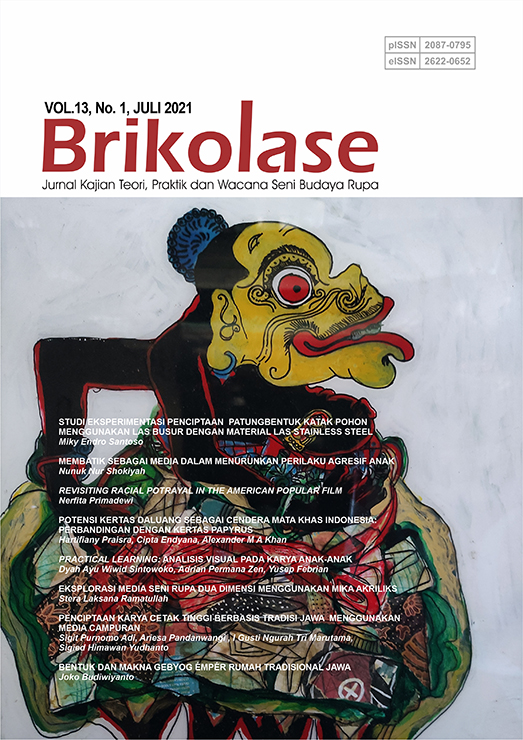BENTUK DAN MAKNA GEBYOG ÉMPÉR RUMAH TRADISIONAL JAWA
DOI:
https://doi.org/10.33153/brikolase.v13i1.3653Keywords:
Javanese House, Gebyog Form, Gebyog Meaning, Gebyog émpérAbstract
The background of this research is that the Javanese house gebyog has a variety of shapes, is beautiful, but has almost the same pattern. The shape and size of the gebyog always follow the size of the Javanese house. The number of gebyog is always odd. However, not all Javanese houses use gebyog émpér. Only Javanese houses in rural areas with closed pendhapas have gebyog émpér. The relationship between the form of gebyog émpér and the spatial pattern of a traditional Javanese house in the meaning that is hidden behind its beauty is interesting. This study aims to determine the form and meaning of the Javanese house gebyog émpér. The research strategy uses qualitative. The research locations include the cities of Surakarta, Wonogiri, Sragen, Sukoharjo, Klaten, and Karanganyar. Sources of data extracted include informants and artifacts. Data collection techniques used in-depth interviews and observation techniques. The analysis technique uses interactive techniques. The results of the study are as follows, the pattern of gebyog forms is varied and symmetrical. Gebyog èmpèr controls the entrance from an unlimited free area to a restricted space due to possession and more.Downloads
References
Ahimsa Putra, H. S. (1999). Ketika Orang Jawa Nyeni. Galang Press.
Budiwiyanto, J. (2010). Makna Penataan Interior Rumah Tradisional Jawa. Pendhapa, 1(1 Oktober). https://doi.org/https://doi.org/10.33153/ornamen.v10i1.1047
Budiwiyanto, J. (2013). Rumah Tradisional Jawa Dalam Sudut Pandang Religi. Ornamen, 10(1), 1–20. https://doi.org/doi: https://doi.org/10.33153/ornamen.v10i1.1047
Ching, F. D. K. (2007). Arsitektur: Bentuk, Ruang, dan Tatanan. Erlangga.
Miles, Matthew B., A. M. H. (1992). Analisis Data Kualitatif: Buku Sumber tentang Metode-Metode Baru. UI Press.
Moleong, L. J. (1985). Metodologi Penelitian Kualitatif. PT. Remaja Rosdakarya.
Palmer, R. E. (2016). Hermeneutik Teori Baru Mengenai Interpretasi. Pustaka Pelajar.
Sachari, A. (2002). Estetika Makna, simbol, dan Daya. Penerbit ITB.
Salim, A. (2006). Teori dan Paradigma Penelitian Sosial. Tiara Wacana.
Soedarsono, R. . (2001). Metodologi Penelitian seni Pertunjukan dan seni Rupa. Masyarakat Seni Pertunjukan Indonesia.
Soekiman, D. (2002). Kebudayaan Indis dan Gaya Hidup Masyarakat Pendukungnya di Jawa (Abad XVIII-Medio Abad XX). Bentang Budaya.
Sutedjo, S. B. (1985). Peran, Kesan, dan Pesan Bentuk-Bentuk Arsitektur. Djambatan.
Sutopo, H. (2002). Metodologi Penelitian Kualitatif, Dasar Teori dan Terapannya dalam Penelitian. Sebelas Maret University Press.
Downloads
Published
How to Cite
Issue
Section
License
Copyright (c) 2021 Joko Budiwiyanto

This work is licensed under a Creative Commons Attribution 4.0 International License.
Author continues to retain the copyright if the article is published in this journal. The publisher will only need publishing rights



